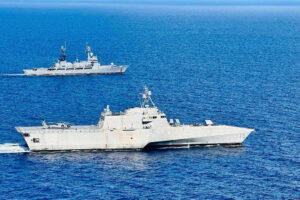
Philippine military defends joint air patrols with US
THE ARMED Forces of the Philippines (AFP) said on Tuesday that its joint air patrol with the United States over the South China Sea early this week had followed international rules and was aimed at boosting their interoperability.
Three Philippine fighter jets and a US bomber aircraft flew over the disputed waterway on Monday, over a week after their navies held drills at sea.
In a statement, the AFP said it was the air component of its 3rd Maritime Cooperative Activity (MCA) with the United States Indo-Pacific Command (USINDOPACOM) which began in early February.
The activity was aimed at boosting the AFP’s capability to “perform its mandate and maintain its presence over the Philippines’ exclusive economic zone (EEZ).”
“[It] demonstrates the commitment of both armed forces to enhancing interoperability and advancing regional peace and security in the Indo-Pacific.”
The Chinese military earlier accused the Philippines of stirring up trouble in the South China Sea by conducting a joint air patrol with “extraterritorial countries” and then openly hyping it up.
The activity is “in no way directed towards any country,” Philippine Air Force spokesperson Ma. Consuelo Castillo told reporters.
It is in line with the international rules, “as we were operating within our territory and within the Philippines’ EEZ,” she added.
The joint air patrol covered areas 90 nautical miles west of Candon, Ilocos Sur and 50 nautical miles northwest of Lubang, Occidental Mindoro.
Last Feb 9, the third iteration of the MCA involved the Philippine Navy’s BRP Gregorio del Pilar and the US Navy’s USS Gabrielle Giffords. Exercises included passing, communication, and division tactics to enhance coordination between the two forces in maritime scenarios.
Previous iterations took place in January and November last year.
The Philippines, particularly under the Marcos administration, has sought closer ties with the US amid escalating tensions with China, which claims vast portions of the South China Sea, including areas within Manila’s exclusive economic zone. — Kyle Aristophere T. Atienza



